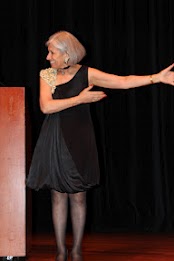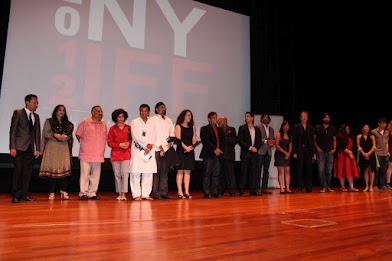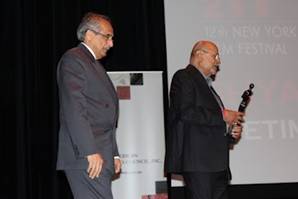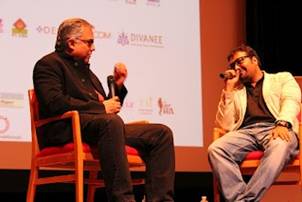 
The Indo-American Arts Council executive director Aroon Shivdasani (left) called onto the stage all award winners (right), at the end of the Twelfth New York Indian Film Festival, held on May 23 - 27. The award ceremony took place at New York University’s Skirball Center for the Performing Arts, on May 27.
(Pictures are by Archana Desai)
New York Indian Film Festival
Has Done India Proud
By M. P. PRABHAKARAN
The Indo-American Arts Council, established in 1998, has been at the forefront of organizations engaged in promoting India’s arts and culture in the United States. It hosts numerous events – book launching, music concert, dance recital, art exhibition and so on – throughout the year, introducing to American audiences writers, artists, actors and performers from the Subcontinent and from among the Indian Diaspora.
Three events, which the IAAC has been hosting in New York annually, have steadily grown in influence and popularity: the New York Indian Film Festival, originally known as the Mahindra Indo-American Arts Council Film Festival, started in 2001; the Erasing Borders Exhibition of Contemporary Indian Art, started in 2004; and the Erasing Borders Festival of Indian Dance, started in 2008. This year’s Erasing Borders events received rave reviews from the media, both American and Indian-American.
According to Aroon Shivdasani, the IAAC’s executive director and co-founder, the “flagship event” of her organization is the New York Indian Film Festival. Born “in response to [then] Mayor [Rudolph] Giuliani’s call to New Yorkers to help rebuild a limping city,” after the September 11, 2001, terrorist attacks, the festival has grown into something that the Indian community in New York and nearby states look forward to attending every year. This year’s festival, held on May 23 through 27, presented more than 50 items – features, documentaries and short films.
“We had to make some tough choices” in eliminating four-fifths of the 250-plus entries, says the director of the film festival, Aseem Chhabra. Though he and the other members of the programming committee had a tough time making the choices, they did a good. The films they chose for presentation stood out for their quality of production and content. Apart from Mr. Chhabra and Ms. Shivdasani, the four-member committee included Professor Satish Kolluri of Pace University and documentary film maker Parvez Sharma.
What the committee presented – starting with Bedabrata Pain’s Chittagong and ending with Anurag Kashyap’s Gangs of Wasseypur – was a smorgasbord catering to varied tastes. The themes of the films ranged from patriotism to gangsterism, but each with a powerful message for the society at large. And the producers and directors ranged from veterans like Shyam Benegal to amateurs and novices, some fresh from film schools and others still studying there. The latter deserve all the encouragement and support they can get. It is to the credit of the programming committee that it decided to give them some exposure at an important event like this festival. For those amateurs and novices, especially students among them, the festival could as well be a launching pad to successful careers in filmdom.
In addition, the shorts coming out of Mira Nair's film school in Uganda, including Moccasins and Zubu and the Photo Fish, were fascinating and gave the festival its broadest international scope ever.
Award Recipients
There was a general award – for Special Contribution to Indian Cinema. It was won by actor/director Rituparno Ghosh.
The Hindi film (with English subtitles) Gattu, directed by Rajan Khosa, won the Best Film Award. Premiered at the 62nd Berlin International Film Festival, Gattu is set in a small Indian town, whose sky is full of kites and whose kids are obsessed with kite flying. The story centers on an illiterate street urchin who takes upon himself the challenge of finding out why a kite called Kali always rules the skies and why no one knows who flies it. The message of the film: “Dreams aren’t impossible when the desire is strong.” Gattu also bagged the Best Young Actor Award. It was won by Mohammad Samad.
The Best Director Award went to Sujay Dahake for directing Shala, a Marathi film with English subtitles. Shala (meaning school), also won the Best Screenplay Award, which went to Avinash Deshpande. Set in the “turbulent India” under the Emergency rule imposed by the late Prime Minister Indira Gandhi in 1975-77, Shala is “a story of love, of circumstances, of passion, of friendship and of freedom.” Shala is based on the novel of the same title, by Milind Bokil.
The Hindi film (with English subtitles) Dekh Indian Circus, directed by Mangesh Hadawale, bagged both the Best Actress and the Best Actor Awards. They were won, respectively, by Tannishtha Chatterjee and Nawazuddin Siddiqui.
Award for Best Documentary went to Saving Face, by Daniel Junge and Sharmeen Obaid-Chinoy. The documentary, in Urdu with English subtitles, depicts a despicable crime committed against women, especially in Pakistan. It is known as acid attack. Women get defaced when their estranged husband and in-laws vent their anger by pouring acid on them. Most of the cases go unreported. Saving Face has brought this scourge to the consciousness of the world by documenting two acid-attack victims’ agony and their determination to bring their assailants to justice. It also documents the laudable, humane services rendered, in rehabilitating them through reconstructive surgery and counseling, by the London-based, Pakistani-born Dr. Mohammad Jawad. The fact that Saving Face has also won this year’s Oscar for Best Documentary is a testament to the power of its theme. Bombay Snow, by Chinmay Dalvi, won the Best Short Film Award. The Audience Choice Award went to Bornila Chatterjee, for her first feature film, Let’s Be Out, The Sun Is Shining.
A Curious Category
There was an award category I never heard of before: film made by cell phone. If in setting up this category the festival committee was setting a new trend, it deserves to be congratulated. With cell phones bringing about rapid changes in society, the trend is going to gain popularity. The Award for One-Minute Cell Phone Film was won by Caroline Cantone, a New York University student, for her film Love Lost.
The finale of the award ceremony was the bestowing of the Lifetime Achievement Award. The recipient was Shyam Benegal, a household name among movie-goers in India. Early on in the festival, the attendees were treated to a trilogy from Benegal’s repertoire – Mammo, Sardari Begum and Zubeida. All three were based on personal stories of Khalid Mohammed, Mumbai's well-known journalist, critic and filmmaker. Mammo tells the story of a Muslim family – Khalid’s family – torn apart when the Subcontinent got partitioned into India and Pakistan. Khalid is the son of Hindi film actress Zubeida Begum and the film Zubeida tells her story.
Starting from early 1970s, Shyam Benegal has produced and directed numerous films and won several prestigious awards. The Indian government honored him with a Padma Shri in 1976 and a Padma Bhushan in 1991. He has already won another lifetime achievement award, perhaps the highest and the most prestigious film award given in India – the Dadasaheb Phalke Award.
Holding the second lifetime achievement award in hand, Mr. Benegal told the audience assembled at New York University’s Skirball Center for the Performing Arts: “Usually, after receiving a lifetime achievement award, the recipient is expected to retire. I have no plan to retire.” The audience laughed, with applause to boot.
At the party after the award ceremony, I bumped into the real moving force behind the whole festival, Aroon Shivdasani. I couldn’t help giving her a hug and exclaiming: “Where do you get the energy from to do all this? You do India proud.”  
Picture left: Shyam Benegal addressing the audience after receiving the Lifetime Achievement Award, at the Twelfth New York Indian Film Festival. To his right is veteran Indian diplomat Vijayan Nambiar who presented the award.
Picture right: Aseem Chhabra, the festival director, interviewing Anurag Kashyap, producer-director of Gangs of Wasseypur. The film, which was the final film presented at the festival, was also one of the three Kashyap films – two parts of Gangs of Wasseypur and Peddlers – selected for screening at this year’s Cannes Film Festival. Mr. Kashyap flew into New York straight from Cannes on the last day of the New York festival. (Pictures are by Archana Desai)
(Published on May 31, 2012.)
(Readers are invited to comment. Send the comments to letters@eastwestinquirer.com) |

